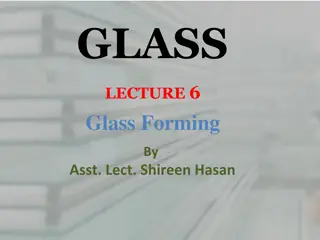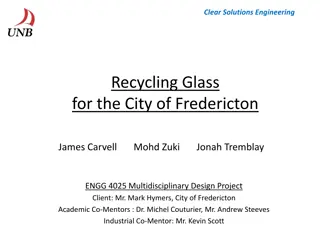Understanding Glass Composition, Properties, and Industrial Processes
Industrial glass, favored for its lustre, transparency, and durability, is a solid material with a liquid atomic structure. Formed by preventing crystalline ordering during cooling, glass exhibits unique properties like viscosity allowing for continuous production processes. This article details the composition, properties, and formation of glass from molten liquids, alongside insights into industrial glassmaking processes and historical evolution.
Download Presentation

Please find below an Image/Link to download the presentation.
The content on the website is provided AS IS for your information and personal use only. It may not be sold, licensed, or shared on other websites without obtaining consent from the author. Download presentation by click this link. If you encounter any issues during the download, it is possible that the publisher has removed the file from their server.
E N D
Presentation Transcript
Chemical Process Industries University of Diyala Chemical Engineering Department Lecture (5) .
Industrial glass Industrial glass, also called architectural glass, solid material that is normally lustrous and transparent in appearance and that shows great durability under exposure to the natural elements. These three properties lustre, transparency, and durability make glass a favoured material for such household objects as windowpanes, bottles, and lightbulbs
However, neither any of these properties alone nor all of them together are sufficient or even necessary for a complete description of glass. Defined according to modern scientific beliefs, glass is a solid material that has the atomic structure of a liquid. Stated more elaborately, following a definition given in 1932 by the physicistW.H. Zachariasen, glass is an extended, three-dimensional network of atoms that form a solid which lacks the long-range periodicity (or repeated, orderly arrangement) typical of crystalline materials.
Normally, glass is formed upon the cooling of a molten liquid in such a manner that the ordering of atoms into a crystalline formation is prevented. Instead of the abrupt change in structure that takes place in a crystalline material such as metal as it is cooled below its melting point, in the cooling of a glass-forming liquid there is a continuous stiffening of the fluid until the atoms are virtually frozen into a more or less random arrangement similar to the arrangement that they had in the fluid state.
Conversely, upon application of heat to solid glass, there is a gradual softening of the structure until it reaches the fluid state. This monotonically changing property, known as viscosity, enables glass products to be made in a continuous fashion, with raw materials melted to a homogeneous liquid, delivered as a viscous mass to a forming machine to make a specific product, and then cooled to a hard and rigid condition.
This article describes the composition and properties of glass and its formation from molten liquids. It also describes industrial glassmaking and glass-forming processes and reviews the history of glassmaking since ancient times. In doing so, the article focuses on the composition and properties of oxide glasses, which make up the bulk of commercial glass tonnage, and on conventional thermal-fusion, or melt-glass, methods of glassmaking. However, attention also is given to other inorganic glasses and to less conventional production processes.
Glass Compositions And Applications Oxide glasses Silica-based Of the various glass families of commercial interest, most are based on silica, or silicon dioxide (SiO2), a mineral that is found in great abundance in nature particularly in quartz and beach sands
Glass made exclusively of silica is known as silica glass, or vitreous silica. (It is also called fused quartz if derived from the melting of quartz crystals.) Silica glass is used where high service temperature, very high thermal shock resistance, high chemical durability, very low electrical conductivity, and good ultraviolet transparency are desired. However, for most glass products, such as containers, windows, and lightbulbs, the primary criteria are low cost and good durability, and the glasses that best meet these criteria are based on the soda-lime-silica system. Examples of these glasses are shown in the table Composition of representative oxide glasses.
After silica, the many soda-lime glasses have as their primary constituents soda, or sodium oxide (Na2O; usually derived from sodium carbonate, or soda ash), and lime, or calcium oxide (CaO; commonly derived from roasted limestone). To this basic formula other ingredients may be added in order to obtain varying properties. For instance, by adding sodium fluoride or calcium fluoride, a translucent but not transparent product known as opal glass can be obtained. Another silica-based variation is borosilicate glass, which is used where high thermal shock resistance and high chemical durability are desired as in chemical glassware and automobile headlamps. In the past,leaded crystal tableware was made of glass containing high amounts of lead oxide (PbO), which imparted to the product a high refractive index (hence the brilliance), a high elastic modulus (hence the sonority, or ring ), and a long working range of temperatures. Lead oxide is also a major component in glass solders or in sealing glasses with low firing temperatures.
Finish Grinding Other silica-based glasses are the aluminosilicate glasses, which are intermediate between vitreous silica and the more common soda-lime-silica glasses in thermal properties as well as cost; glass fibres such as E glass and S glass, used in fibre-reinforced plastics and in thermal- insulation wool; and optical glasses containing a multitude of additional major constituents.























